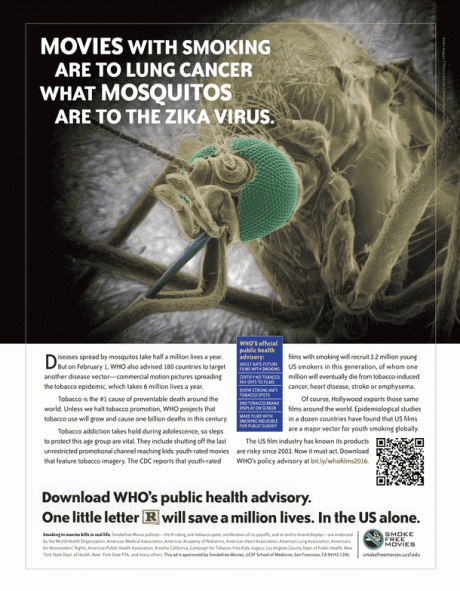March 4, 2016
We just submitted this public comment to the FDA. The tracking number is 1k0-8ob6-gewv. (PDF version)
RJ Reynold’s Unpublished Randomized Controlled Trial Finds that Camel Snus is Not Effective for Smoking Cessation
Docket No. FDA-2016-N-0073
Eunice E. Neeley, MD, MPH, Lauren K. Lempert, JD, MPH, Stanton A. Glantz, PhD
Center for Tobacco Control Research and Education, University of California, San Francisco
RJ Reynolds’ Unpublished Study on Camel Snus Compared to Nicotine Replacement Therapy for Smoking Cessation is Responsive to FDA’s Request for Studies Regarding Predictors of Consumer Initiation, Uptake, and Use of a Tobacco Product
March 2, 2016
Dr. Robert Schwartz from Ontario Canada has prepared a wonderful short video explaining how we can be so certain that smoking in movies causes kids to smoke and why the R rating (18A in Canada) will save lives and money.
Check it out here.
This is cross-posted from the Smoke Free Movies blog at http://smokefreemovies.ucsf.edu/blog/fantastic-short-video-science-behin...
March 2, 2016
According to the Associated Press, the Department of Transportation finally allowed the Department of Transportation to prohibit the use of e-cigarettes on airplanes. It has taken years to get this rule and it comes after all the US airlines I have flown on recently already voluntarily prohibited using e-cigs on their flights.
Now that the White House Office of Management and Budget has let DOT do this, it is past time for them to approve the FDA "deeming rule" that has been sitting at OMB for months (since October 2015). Early last year FDA officials were saying to expect the rule by June 2015. It is not March 2016. In the mean time, youth use continue to explode and the evidence that e-cigs inhibit adult quitting keeps piling up.
February 25, 2016
Ever since we launched the Smoke Free Movies campaign in March 2001, I have been wondering when there would be a lawsuit against the MPAA and the major studios it represents for continuing to allow smoking in movies it rates as suitable for youth.
On February 25, 2016 the inevitable happened.
A national class-action lawsuit was filed against the Motion Picture Association of America (MPAA), Disney (NYSE: DIS), Paramount (NASDAQ: VIAB), Sony (NYSE: SNE), Fox (NASDAQ: FOX), Universal (NASDAQ: CMCSA), Warner Bros. (NYSE: TWX) and the National Association of Theatre Owners (NATO), on the grounds that these companies and trade groups negligently awarded youth-ratings (G, PG, PG-13) to top-grossing films with tobacco imagery.
The lawsuit states that the defendants misrepresented these films as suitable and appropriate for children and adolescents despite having been informed repeatedly since 2003 that films with tobacco recruit large numbers of U.S. children to smoke and that R-rating future films with tobacco imagery would avert as many as one million tobacco deaths in this generation of U.S. children.
February 14, 2016
New Smoke Free Movies ad running in Variety this week publicizes the new WHO report Smoke Free Movies: From Evidence to Action (available in English and Spanish).

